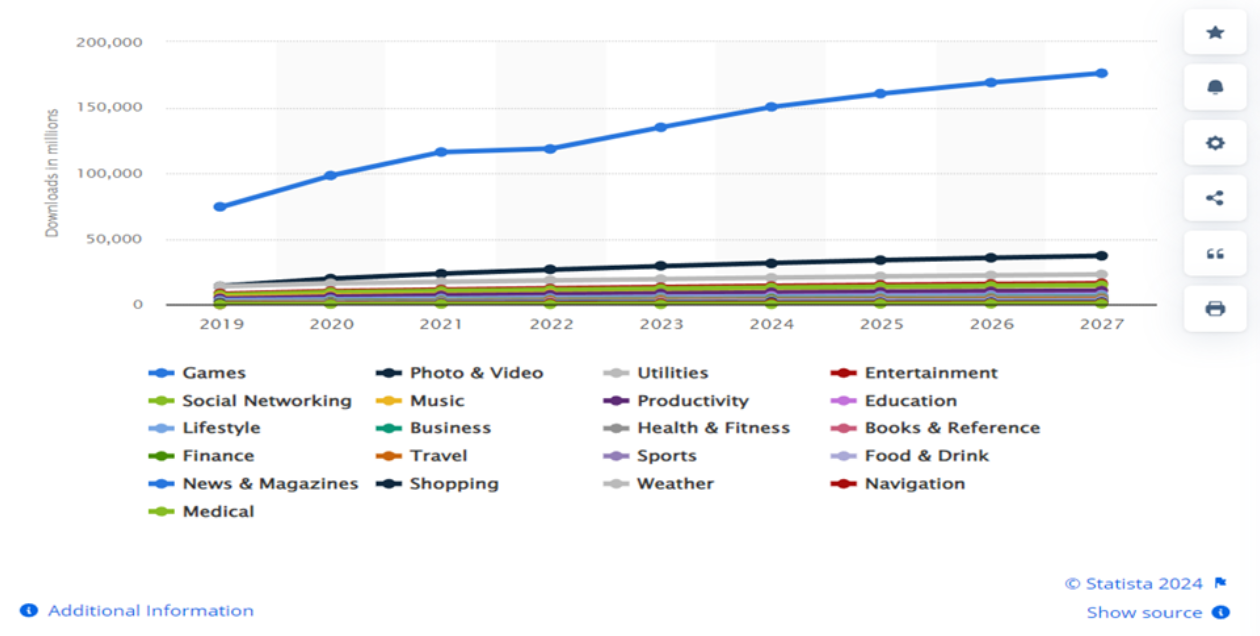
Top 5 Mobile App Development Frameworks to Rule in 2024
Introduction
Mobile apps have become the lifeline for businesses in today’s age of digitalization.
So, in this mobile-driven era, choosing the proper mobile app development framework for developing apps is very important. As we have already stepped in 2024, seeking information about the top mobile app development frameworks to rule in 2024 can guide you through critical decision-making.
This blog sheds light on the key stats and facts on the growth of mobile app development. Additionally, it provides insights into the top five mobile application frameworks for 2024, highlighting the critical features, benefits, limitations, and usage of each.
Now, let’s dive deeper.
Key Stats and Facts on Mobile App Development Growth
- The projected market volume in 2027 is expected to reach US $673.80 billion with an annual growth rate (CAGR 2022-2027) of 8.83%.
- Average smartphone users spend 90% of their time on apps.
- By 2024, it is estimated that mobile apps will generate over $935 billion in revenue.
- The growth of mobile app downloads is more expensive than just established markets.
Mobile App Downloads Worldwide by Segments from 2019 to 2027

Source: Statista
Before delving into the specifics, it’s crucial to understand what the mobile application development framework entails.
What are Frameworks in Mobile App Development?
A mobile app development framework gives the foundation on which the mobile apps are developed. It renders predefined classes and functions, allowing mobile app developers to write applications, thus decreasing the need to create the application from scratch.
Thus, frameworks allow for streamlining the development process, making it faster, more competent, and error-free.
“Frameworks are the tapestry of innovation, weaving together technology and creativity to create inspiring mobile experiences.”
Top 5 Mobile App Development Frameworks Set to Dominate in 2024
Here are the top five mobile app development frameworks that are set to dominate in 2024.
React Native
React Native, developed by Facebook, is a JavaScript Framework that is predicted to rule in 2024. It allows developers to develop mobile applications with a single codebase for both Android and iOS.
Critical Features and Benefits
Component-Based Architecture: Like React, React Native framework for mobile application development highlights component-based architecture, thus enabling reusability and effectual app updates.
JavaScript Core: Uses Java Script, one of the most widely used languages, to assist several web developers in performing a shift to mobile app development.
Hot Reloading: Provides scope for the developers to see the latest changes done quickly, thus improving developers’ output.
Native Modules: React native integrate with Native code when required, offering scalability and optimized performance for specific tasks.
Vast Community and Ecosystem: Because of its widespread usage, a large and active community has developed, resulting in many plugins, libraries, and tools to cater to various needs.
Limitations
React Native mobile app development framework may not be ideal for computationally intensive applications and may require native code for specific functionalities.
Usage
- High-profile companies like Facebook, Walmart, and Pinterest have used React Native for mobile apps.
- It promises to render faster development cycles, integrated with the capacity to deliver near-native performance.
- This makes the framework for mobile app development an ideal choice for businesses seeking to establish a mobile presence quickly.
Flutter
An Open-Source UI software development toolkit, Flutter, developed by Google, is another significant mobile app development framework expected to dominate in 2024. Designed previously for mobile, the Flutter framework for mobile application development offers the scope to develop natively compiled applications for Android and iOS through a single codebase.
Critical Features and Benefits
- Dart Programming Language: Flutter uses Dart as a programming language to build high-quality native interfaces on Android and iOS using a single codebase.
- Cross-Platform: Write once and use it on iOS and Android, rendering consistency and saving time.
- Hot Reload: This feature lets developers see the changes instantly without reloading the app, thus enhancing productivity.
- Widget-Based: Flutter employs a widget-based architecture, where UI components and layout are widgets that can be combined in various ways.
- Performance: Flutter’s native ARM code and graphics engine enable fast and fluid UI for high-performance mobile app development on iOS and Android with a single codebase.
Limitations
The app is quite large, and learning Dart can be challenging because of its steep learning curve.
Usage
- The potential of having a single codebase that provides excellent performance, along with Google’s support, gives Flutter a bright future in the cross-platform development field. Big companies like Google Ads, eBay, and BMW have used Flutter for their mobile apps.
- Commits to offer a unified codebase without sacrificing performance.
- Startups and established businesses can benefit from Flutter’s capabilities, allowing them to launch products quickly and expand their app’s reach.
Xamarin
Xamarin comes next in the list of top five mobile app development frameworks in 2024. This specific framework for mobile application development is used for developing apps that can run on multiple platforms. It allows developers to utilize a single codebase to create iOS, Android, and Windows apps. By using .NET and C#, Xamarin offers a platform that provides the performance of native development along with the versatility and ease of code sharing.
Critical Features and Benefits
Combined Development Environment: Xamarin framework for mobile app development utilizes Microsoft Visual Studio, providing a complete set of tools for development, testing, and deployment.
Single Codebase: Using one #C codebase, the developers can develop apps for multiple platforms. Hence speeding up the process of development.
Native Performance: Xamarin compiles apps to native code for each platform, ensuring high performance on par with Java for Android and Swift/Objective-C for iOS.
Robust base library: Xamarin provides a vast library of class libraries for mobile development using the power of the .NET framework.
Full Access to Native APIs: App developers are not restrained and can utilize the whole gamut of functionality accessible on each platform.
Limitations
App sizes occasionally cause delays in supporting the latest platform updates.
Usage
- The World Bank, Fareboom, and Olo giants have relied on Xamarin for mobile application development. Because of its native performance, a complete library set, and a rich development environment.
- Developers can use Xamarin.Forms to create UI layouts that can be shared across iOS, Android, and Windows apps.
- Xamarin is integrated into Microsoft’s ecosystem, which makes it easier to integrate with Azure. – Azure integration enables seamless backend cloud integration.
Ionic
Ionic takes its place as the subsequent contender in the lineup of leading mobile app development frameworks. Recognized for its versatility, Ionic is an open-source platform empowering developers to construct cross-platform mobile, web, and desktop applications. By harnessing the power of JavaScript, HTML, and CSS, Ionic facilitates efficient development processes while guaranteeing a consistent and intuitive user experience across diverse devices and platforms.
Critical Features and Benefits
Wide-ranging UI Components: It provides a wide range of pre-designed elements that can be modified according to your needs and are tailored to specific platforms.
Ionic CLI and Tools: Ionic mobile app development framework is equipped with a robust command-line interface and other development tools, streamlining the development process.
Single Codebase: By utilizing well-known web technologies, developers can use Ionic to create cross-platform applications with a single codebase.
Performance: This feature guarantees seamless animations and responsive touch gestures, creating an experience that feels like using a native application.
Community and Ecosystem: The Ionic framework provides numerous advantages through its extensive community and the availability of various plugins and integrations.
Limitations
It may not render as smooth an experience as native apps.
Usage
- Some great apps built with Ionic include Nationwide, Pacifica, and JustWatch.
- Due to its flexibility and efficiency, more businesses and startups are opting for this specific mobile app development framework.
- Ionic is a good option for businesses building high-performing, cross-platform applications without sacrificing user experience.
Kotlin Multiplatform
Finally, Kotlin Multiplatform (KMP) is predicted to be another mobile app development framework to rule in 2024. Developed by JetBrains, it simplifies code sharing across platforms while retaining the benefits of native programming. KMP allows developers to reuse code, write native code when needed, and build cross-platform applications on multiple platforms. This makes it ideal for building robust, versatile, and high-quality apps.
Critical Features and Benefits
- Cross-Platform Code Reusability: Developers can reuse code across Android and iOS platforms, web, desktop, and server-side, saving time and effort while keeping native code when required.
- Seamless Integration: Kotlin Multiplatform can be easily integrated into any project, allowing developers to make the most of native and cross-platform development while utilizing platform-specific APIs.
- Modern Declarative Cross-Platform UI Framework: Compose Multiplatform is a modern declarative cross-platform UI framework developed by JetBrains, which provides developers with a more efficient way to create UI while sharing the same codebase across various platforms.
- Complete code-sharing flexibility: Compose Multiplatform enables the sharing of both the UI and logic, leading to increased development speed and efficiency while reducing costs and time-to-market.
- No Need to Introduce a New Language: By leveraging Kotlin Multiplatform, developers can reuse their existing Kotlin code and expertise, making migrating to this technology less risky compared to other technologies.
Limitations
Kotlin Multiplatform supports some libraries and frameworks of all platforms it targets, which may limit its usability to specific projects.
Usage
- Mcdonald, Forbes, and Netflix like big companies’ have adopted Kotlin for their mobile app development.
- Kotlin Multiplatform can significantly reduce development time and costs for entrepreneurs who need to brace multiple platforms.
- Supports native UI development, which can help entrepreneurs create consistent user experiences across multiple platforms.
Ready to take your app development strategy to the next level? Contact us today to schedule a consultation with our team of experts
Ending Lines
As the world increasingly relies on mobile apps for various purposes, choosing the proper framework for app development is more critical than ever. The top five mobile app development frameworks in 2024 listed above have their unique strengths and limitations. Depending on specific requirements, budget, and target audience, businesses must choose the framework that best suits their goals. It is essential to remember that while the framework is necessary, the developer’s skill and expertise can make all the difference in the quality of the final product.
Consequently, seeking guidance from a trustworthy mobile app development services provider like Mind IT Systems is highly recommended. This will ensure you select the correct framework and hire the top 1% app developers to manage your mobile app projects.
Do follow us for more insightful blogs on tech trends. We publish a new blog every week in our blog section.
Share this post
About the Author

Sujoy Roy
(Head – Digital Marketing)
From my teenage time, I had a quench to solve problems and loved leadership. Starting my career in relation management, ignited my passion for managing people. While managing I realized technology needs to be incorporated to keep pace with the changing world & do my work efficiently.

